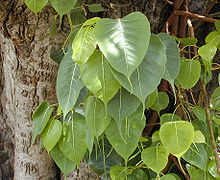Pipal A Sacred Tree
G.L Khajuria
Pipal
is a large deciduous tree with grey bark and is predominantly prominent of its
religious affiliation in almost all the spiritual rituals. ln Hindu families,
the ladies are mostly ordained of this religious tree and worship it for the
longevity of their husbands. Even otherwise also, the tree is watered in the
morning by every Hindu and it showers blessings as poetized in our revered
Vedas and Purana. It is exorcising and gives maximum oxygen and is of ample
importance for shade as Lord Sudha attained salvation and spiritual
enlightenment under Pipal tree at Sarnath situated barely five miles away from
Varanasi. The place is now of ample importance due more so that most of the
Buddist pilgrimage are in existence, apart from the existence of Ashoka’s pillar
of remote past and subsequently adopted by the Republic of our country
(Ashoka’s Chakra) after the dawn of independence.
The tree is spoken in botanical parlence as Ficus religiosa’ belonging to the
family urticaceae of plant kingdom. ln the olden days, the people have had an
extensive interest in the propagation of these trees to provide shade to all
travelers over long distance when the national highways were scanty and road
connectivity was very poor. The tree is having its inhabitation commonly throughout
India in tropical zones and mostly cultivated alongside road near ponds (Talab)
and temples and other religious places as it is mostly watered after having
bath in the pond over the ages. It as well find its existence in the tropical
and sub-tropical forests amongst other trees, bushes, herbs, shrubs and plants
of lower strata.
The morphological charactertics of the tree are quite exuberant and share its
own importance unmatching other broad – leaved species. The trunk of the tree
is irregularly shaped having alternate leaves on the twigs and the leaves are
orbicular – ovate, thinly corriacious but tough, shining above, reddish when
young, white tubereled when mature; undulate; main lateral nerves are 6-7
pairs, joined by prominent closely reticulate veins; base is shallow chordate
rounded or truncate.
The tree is prominently a sanctimonious one and is held with much veneration by
Hindus especially near temples and wells, oftenly catching a height upto 900 ft
in the outer Himalayas. Being a sanctified tree, its felling or axing is
considered sinful, second only: to the Killing of a Brahman that is why the
tree is regularly watered after early bath in the morning by men of all hues
and ladies usually worship this tree for the longevity of their husbands. Wood
of the tree is greyish-white, moderately hard, not so mottled as of its
relative species viz. Ficus arnottiana and when the trees get old and dried;
the firewood is used in cremation as its wood is considered as sanctimonious.
The tree finds its existence in Sub Himalayan tract and outer hills, ascending
to greater height from Chenab eastwards to Marwara, Assarn, lower Bengal. In
the eastern part of India. The tree is vernacularly Spoken as Pipal or Pares.
The trees Of pipal found in the Jaunsar catches a lower heights up to 60ft as
elsewhere in Garhwal, Ajmer, Bihar, Central provinces, Nagpur. Western
Peninsula in the Deccan and near the coastal areas in the south tips of the
Indian Ocean up to bay of Bengal.
The branches and leaves find It their usefulness as the best fodder for
elephants and its leaves are also used on all rituals and other ceremonies
amongst Hindu families. The milky juice or sap of the tree is hardened into a
substance resembling that of Guttapercha’. It is rather a fast growing tree and
finding its importance in the ‘arboriculture’ (avenues plantations) and further
it is of ample importance in its propagation through- branches-and cuttings.
However. of course, the tree is an epiphyte and prove to be destructive
oftenly- when it grows by sending its roots down through the crevices of big
buildings and monuments.
A large shrub or a small trees also find its existence oftenly as epiphyte
creeping over rocks having the characterstics of broad ovate base corbate and
densely clustered basal branches with bracts being membranous. Flowering of the
tree usually-take-place in April – May
The tree is of immersive importance amongst all-other trees in the biological
ecosystem as it exudes maximum oxygen into air and at the same time absorbing
CO2 and other Poisonous gases emanating from industrial emission coupled with
enormous pollution off shooting from multihued vehicles which by every day’s
turn dilutes pollution into the air. So, it becomes more pertinent for the
extensive plantation of this tree all over the globe most suited to site,
preferably along National Highways, canals, railway tracts, around ponds and
wells and many other wastelands.
But it is no longer a single man’s show we all have to join hands irrespective
of age and gender and perhaps the ;youth have had a far reaching role to play
within the plantation drive.lt is no doubt a self – speaking fact that Forest
Deptt. along with its associate wings are doing yeoman’s service in the
inculcation of this species and abundant stocks are }available in our nurseries
and it is unambiguously the ripe time when we can take in hand advance work
like that of pit work and trenching so that with the onset of Monsoon we are in
a position to carry out massive afforestation work of suchlike trees mentioned
in the body of the-write up and further let us take a pledge for mass movement
in making this mission a success oriented ensuring greening of the globe and
sustainability of all form of biolife and its ecosystem – which is the clarion
call of the day.
Original Source & Cridit: https://statetimes.in/pipal-a-sacred-tree/



Comments
Post a Comment